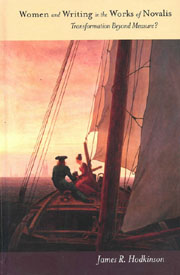Book contents
- Frontmatter
- Contents
- Acknowledgments
- Abbreviations of Major Primary Works Cited
- Typological Conventions in Novalis: Schriften
- Introduction
- 1 Writing in Context: Romanticism, Gender, and the Case of Novalis
- 2 Writing about Women, 1795–99
- 3 Esteem and the Epistolary: Hardenberg and Women of Letters
- 4 Music and the Manifold of Voices: The Subject and the Theory of Polyphony, 1797–99
- 5 From Music to Metamorphosis: Women's Role and Writing in Heinrich von Ofterdingen, 1798–1801
- 6 “Freyes Fabelthum”: The Poetic Construction of Gender in Hardenberg's Religious Writing
- Conclusion: Progression, Reaction, and Tension in Hardenberg's Gender Writing
- Works Consulted
- Index
Introduction
Published online by Cambridge University Press: 05 February 2013
- Frontmatter
- Contents
- Acknowledgments
- Abbreviations of Major Primary Works Cited
- Typological Conventions in Novalis: Schriften
- Introduction
- 1 Writing in Context: Romanticism, Gender, and the Case of Novalis
- 2 Writing about Women, 1795–99
- 3 Esteem and the Epistolary: Hardenberg and Women of Letters
- 4 Music and the Manifold of Voices: The Subject and the Theory of Polyphony, 1797–99
- 5 From Music to Metamorphosis: Women's Role and Writing in Heinrich von Ofterdingen, 1798–1801
- 6 “Freyes Fabelthum”: The Poetic Construction of Gender in Hardenberg's Religious Writing
- Conclusion: Progression, Reaction, and Tension in Hardenberg's Gender Writing
- Works Consulted
- Index
Summary
THIS BOOK DEALS WITH an issue of ongoing controversy among critics and more general readers alike: the autobiographical, theoretical, and literary-aesthetic portrayal of women, or in a more abstract sense the “feminine,” in the writing of Friedrich von Hardenberg (1772–1801). Better known by his chosen pen name “Novalis,” this prolific lyrical poet, novelist, philosopher, and scientist of German Romanticism wrote texts that appear to be shot through both with representations of women and with encounters and dialogues with them, imaginary and fictional. So, too, did he often appear to imbue many of those universal concepts to which writers around 1800 dedicated so much time, “nature,” “the divine,” and even “poetry” itself, with characteristics that have been called “feminine.” More recently, scholars working in the field of contemporary gender studies have even compared Hardenberg's works to modern theory, suggesting that his veneration of the feminine aligns him with feminists who have sought to theorize and practice a feminine way of writing. A discussion seeking both to cover this terrain and to break new ground will, therefore, be wide-ranging and complex. It will also lead inevitably into the fraught ideological and methodological debates at the center of the historical study of gender in the Romantic period. To consider Hardenberg's treatment of gender on all thematic plains, the whole range of his writing, the autobiographical and epistolary, the philosophical and aesthetic, the political, scientific, and theological, and, of course, the literary will be considered.
- Type
- Chapter
- Information
- Women and Writing in the Works of NovalisTransformation beyond Measure?, pp. 1 - 23Publisher: Boydell & BrewerPrint publication year: 2007



